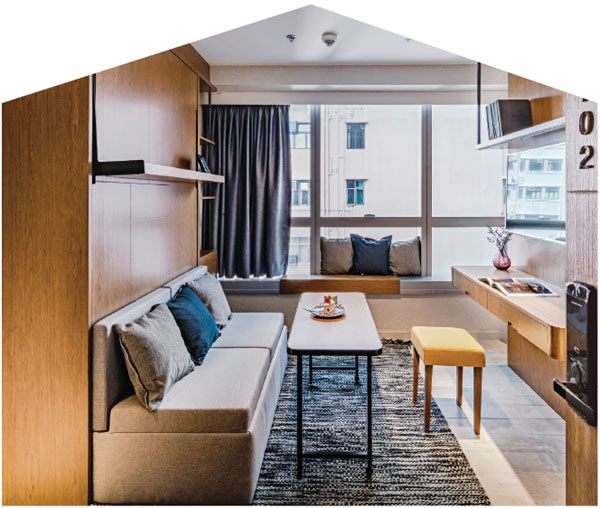Sharing a key
Updated: 2019-11-15 07:48
By Rebecca Lo(HK Edition)
|
|||||||||
In densely populated HK, co-living is fast evolving from a millennial-driven trend into a deliberate lifestyle choice. Rebecca Lo reports.
Co-living has existed in one form or another globally ever since tribes lived together in caves. In Hong Kong, such a lifestyle has historically been intertwined with the city's lack of affordable housing.
"The sharing of living spaces in Hong Kong is not by choice but an outcome of economic and social circumstances," says architect Lee Ho-yin. Head of the Conservation Division at the University of Hong Kong's Faculty of Architecture, Lee identifies the profit-driven approach of Hong Kong's private developers as one of the major factors causing demand to outstrip supply by far.
|
Oootopia's co-living units in Kai Tak, Tai Kok Tsui and Shek Tong Tsui come with Murphy beds. |

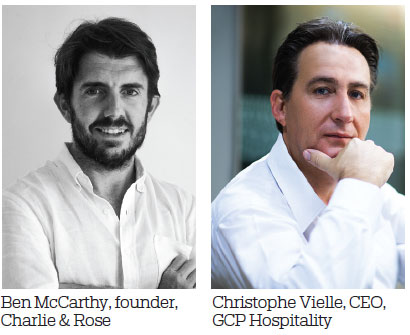
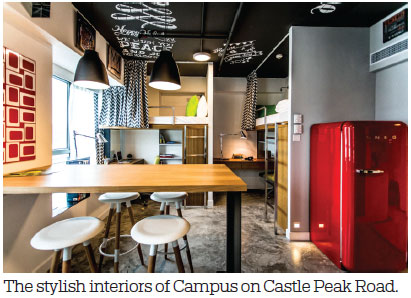
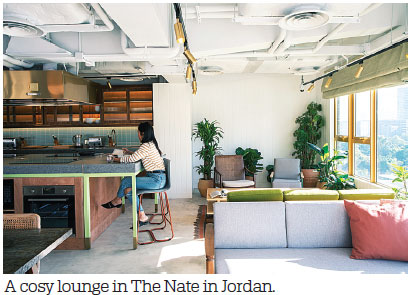
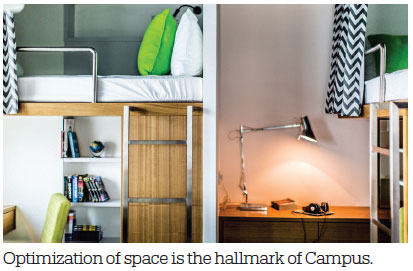
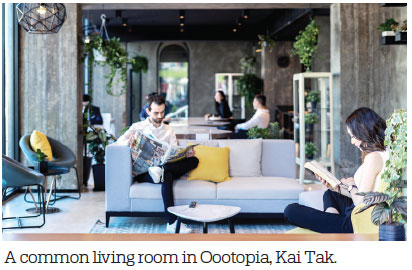
Given that the ever-escalating demand for housing continually outpaces both private and public property supplies in Hong Kong, Lee says that "The city has no choice but to adapt to the sharing of living spaces."
These spaces, however, have not always been glamorous. Lee cites several examples, from the chaotic sharing arrangement in private tenement housing ("think cage homes and subdivided flats," he says) to the more organized sharing arrangement in public housing, which often include communal facilities such as toilets and baths, and improvised kitchens as found along the corridors in early public resettlement blocks.
In recent years though, the idea and practice of co-living has taken a different turn in Hong Kong. Concurrent with government-initiated public housing, creative entrepreneurs are trying to better utilize existing space at the higher end of the price scale.
Compared to shared housing arrangements in the past, Lee says that emerging co-living spaces differ in their intention. "Today's co-living buildings are designed for the purpose, taking design reference from building types with the closest comparable functionality, which happen to be the student dorm and the hotel," says Lee.
The idea of living in stylish, cost-effective iterations of the student dorm has proved to be highly attractive, and not just to the young and trendy. Co-living has become a lifestyle buzzword in Hong Kong that taps into the soul of shared economy's ethos.
Distinctive and stylish
Campus opened in 2015 with three floors in the 12-storey Bay Bridge Lifestyle Retreat. Situated on Castle Peak Road opposite Tsing Yi with views towards Tsing Ma Bridge to the west, Campus offers shared rooms for up to four people with chic common spaces targeting students and millennials. Bolstered by its success, operator GCP Hospitality opened a second Campus in Perth, Australia, last year.
"Our implementation of co-living spaces, first at Campus Hong Kong, was our answer to market needs," says Christophe Vielle, Bangkok-based CEO and co-founder of GCP Hospitality. "Hong Kong has long suffered from high cost of living, especially when it comes to rent and accommodations. By introducing a co-living concept into the market, we offer an affordable yet top-quality choice."
"The use of intelligent design allows us to maximize every inch of space while creating something that provides an unrivalled living experience," Vielle adds.
Developers have since jumped on the co-living bandwagon with distinctive and stylish co-living offerings expertly operated by seasoned hospitality professionals. The Nate and Page 148 are two options that market themselves as part of the co-living experience.
Hip developer District 15 launched The Nate with thoughtful interiors by Ben McCarthy, founder of Hong Kong-based architecture firm Charlie & Rose. It operates 71 fully furnished serviced studios in a high-rise building between Tsim Sha Tsui and Jordan MTR stations.
"There are three main social spaces: the rooftop terrace for harbor views and great parties; the Laundromat for hanging out off the main living space; and the 12th floor living room and kitchen with its big central island," explains McCarthy. "I see the four cooking ranges almost like a campfire, with residents gathered around to cook meals and chat. All of these amenities wouldn't normally exist for a young person on limited funds living outside their parents' home."
The Nate opened in 2018. "The initial expectation was that residents would be mostly 20- to 35-year-old professionals," says McCarthy. "The reality has been quite different. There are a lot of couples, quite a few middle-aged people and some retirees. It's a great thing, like a vertical village, with a diverse range of people valued in a community."
While The Nate requires a month-long minimum stay, the 197-key Page 148 by Butterfly Hospitality Group welcomes stays by-the-night. Opened earlier this year on Austin Road across from Kowloon Cricket Club, Page 148 is akin to a boutique hotel. Its Page Common caf on the ground floor cleverly combines check-in, Wi-Fi hotspot and artisanal coffee with trendy avocado toast. Guests have the opportunity to mix and mingle with the neighborhood's residents at communal tables designed by Johnny and Paul Kember of Hong Kong-based KplusK associates. A second property, Page 8, is slated to launch by the year's end in London near Trafalgar Square.
Community feel
Leaning more towards the serviced apartment end, Oootopia and Weave Co-Living are the latest communal concepts to gain traction. After opening its first location in Prince Edward on Boundary Street, Weave's founder and CEO Sachin Doshi launched a second property in Hung Hom in November.
Oootopia, the brainchild of CEO Lim Boon Cheow, enlisted the talents of Groundwork Architects & Associates' founder, Manfred Yuen who designed the brand's properties in Kai Tak, Tai Kok Tsui and Shek Tong Tsui. For the latter, he also designed custom furnishings, including Murphy beds for the units.
Weave places emphasis on local art and culture partnerships, is entrenched in working-class neighborhoods, and offers a minimum six-month stay. By contrast, Oootopia has a more flexible one-month minimum and is situated in gentrifying districts.
Lim experiences each of his properties to get a sense of how they work while personally interacting with residents. "I thought that we would see mostly young singles and couples," he says, echoing McCarthy of District 15. "But we have had locals and expats from all walks of life: people who are renovating, on short-term contracts, separating from their spouses. (There's) even a single mom with her child. I love that after leaving us, many residents still join our regular activities - as alumni of our community, they drop by to see old friends."
Vielle feels that co-living is a global phenomenon in its infancy, and that a growing awareness about space as a commodity and the limitation of resources has accelerated the popularity of this lifestyle option. "Co-living entails the sharing of resources for the benefit of everyone. Such communities typically make decisions together. For many, it is this sense of being part of a larger family that is often the most appealing part," says Vielle.
McCarthy agrees. He believes co-living marks a shift in the way people choose to live: "Whether it is driven by need or want, housing affordability is a current and global issue. The more developers take appropriate steps to build housing that foster a sense of community like The Nate, the more the chances of co-living becoming a want rather than just a need."
(HK Edition 11/15/2019 page10)
